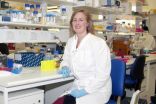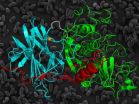(Press-News.org) Medical researchers have used DNA sequencing to identify a gene variant responsible for causing lupus in a young patient.
The development shows that for the first time, it is feasible for researchers to identify the individual causes of lupus in patients by using DNA sequencing, allowing doctors to target specific treatments to individual patients.
Lupus is a chronic autoimmune disease that affects one in 700 Australians, predominantly young and middle aged women.
Medical researchers at the Australian National University's Centre for Personalised Immunology, based at the John Curtin School of Medical Research (JCSMR), sequenced the genes of a young girl who suffered a stroke when she was four as a result of her lupus.
"We can now target her specific disease, and make treatments that will benefit her throughout her life," said lead researcher Dr Julia Ellyard, from the JCSMR.
Researchers identified a variant in the TREX1 gene. This mutation caused the patient's cells to produce a molecule called interferon-alpha. Clinical trials are already underway for drugs to target interferon-alpha in adults.
Dr Jeff Chaitow, head of rheumatology, a co-investigator and the patient's treating clinician at Sydney's The Children's Hospital at Westmead, said his young patient, now 10 years old, still needs regular steroids and immune suppressive drugs each day.
"New targeted therapy would be a major benefit in controlling her disease," he said.
Professor Carola Vinuesa, Co-director of the Centre for Personalised Immunology at ANU, said research was showing lupus was primarily caused by defects in only one or a few genes. "This is the new age of personalised medicine," she said.
"This study shows that it is possible to unravel the detailed and individual genetic causes of lupus in individuals.
"Lupus is a heterogeneous disease and patients can experience a number of different symptoms. We believe that there are different genetic causes of lupus. Understanding these defective genes and pathways in each individual will help tailor treatments."
Professor Matthew Cook, Co-director of the Centre for Personalised Immunology, said the results proved the potential benefits of personalised medicine, where doctors will be able to target treatments to individual patients.
"We are optimistic that this represents proof of principle for a new approach to diagnosis and treatment of a range of complex immunological disease," Professor Cook said.
Genetic key to lupus shows potential of personalized medicine
DNA sequencing of a lupus patient has identified a specific genetic mutation that is causing the disease, opening the way for personalized treatments
2014-08-19
ELSE PRESS RELEASES FROM THIS DATE:
MIPT and RAS scientists made an important step towards creating medical nanorobots
2014-08-19
Researchers from the Institute of General Physics of the Russian Academy of Sciences, the Institute of Bioorganic Chemistry of the Russian Academy of Sciences and MIPT have made an important step towards creating medical nanorobots. They discovered a way of enabling nano- and microparticles to produce logical calculations using a variety of biochemical reactions.
Details of their research project are given in the journal Nature Nanotechnology. It is the first experimental publication by an exclusively Russian team in one of the most cited scientific magazines in many ...
Opioid users breathe easier with novel drug to treat respiratory depression
2014-08-19
Chicago – August 19, 2014 – People taking prescription opioids to treat moderate to severe pain may be able to breathe a little easier, literally. A study published in the September issue of Anesthesiology, the official medical journal of the American Society of Anesthesiologists® (ASA®), found that a new therapeutic drug, GAL-021, may reverse or prevent respiratory depression, or inadequate breathing, in patients taking opioid medication without compromising pain relief or increasing sedation.
"Although opioids such as oxycodone, methadone and fentanyl are commonly ...
Taking a stand: Balancing the BENEFITS and RISKS of physical activity in children
2014-08-19
This news release is available in French. Taking a Stand: balancing the BENEFITS and RISKS of physical activity in children
Today the Canadian Society of Exercise Physiology took a stand on the promotion of childhood physical activity and published their position and recommendations in the journal Applied Physiology, Nutrition, and Metabolism (APNM). This position stand provides an important overview of knowledge in the area of risk of physical activity for children and suggests both practical guidelines and a research agenda. Uniquely, this position stand addresses ...
Researchers block plant hormone
2014-08-19
This news release is available in German.
Researchers trying to get new information about the metabolism of plants can switch off individual genes and study the resulting changes. However, Erich Kombrink from the Max Planck Institute for Plant Breeding Research in Cologne and Markus Kaiser from the University of Duisburg-Essen adopt a different approach. They identify small molecules that block specific components of the metabolic process like brake pads and prevent the downstream reactions. In their search for these molecules, they use a biological selection ...
Exporting US coal to Asia could drop emissions 21 percent
2014-08-19
DURHAM, N.C. -- Under the right scenario, exporting U.S. coal to power plants in South Korea could lead to a 21 percent drop in greenhouse gas emissions compared to burning the fossil fuel at plants in the United States, according to a new Duke University-led study.
"Despite the large amount of emissions produced by shipping the coal such a long distance, our analysis shows that the total emissions would drop because of the superior energy efficiency of South Korea's newer coal-fired power plants," said Dalia Patiño-Echeverri, assistant professor of energy systems and ...
The difficult question of Clostridium difficile
2014-08-19
The bacterium Clostridium difficile causes antibiotic-related diarrhoea and is a growing problem in the hospital environment and elsewhere in the community. Understanding how the microbe colonises the human gut when other "healthy" microbes have been destroyed during a course of antibiotics might lead to new ways to control infection. An important clue was reported recently in an open access article published in the journal Acta Crystallographica Section D Biological Crystallography. [Bradshaw et al. (2014). Acta Cryst. D70, 1983-1993; doi:10.1107/S1399004714009997]
Ravi ...
Zebrafish help to unravel Alzheimer's disease
2014-08-19
New fundamental knowledge about the regulation of stem cells in the nerve tissue of zebrafish embryos results in surprising insights into neurodegenerative disease processes in the human brain. A new study by scientists at VIB and KU Leuven identifies the molecules responsible for this process.
Zebrafish as a model
The zebrafish is a small fish measuring 3 to 5 cm in length, with dark stripes along the length of its body. They are originally from India, but also a popular aquarium fish. Zebrafish have several unusual characteristics that make them popular for scientific ...
Why global warming is taking a break
2014-08-19
Global warming is currently taking a break: whereas global temperatures rose drastically into the late 1990s, the global average temperature has risen only slightly since 1998 – surprising, considering scientific climate models predicted considerable warming due to rising greenhouse gas emissions. Climate sceptics used this apparent contradiction to question climate change per se – or at least the harm potential caused by greenhouse gases – as well as the validity of the climate models. Meanwhile, the majority of climate researchers continued to emphasise that the short-term ...
Has the puzzle of rapid climate change in the last ice age been solved?
2014-08-19
During the last ice age a large part of North America was covered with a massive ice sheet up to 3km thick. The water stored in this ice sheet is part of the reason why the sea level was then about 120 meters lower than today. Young Chinese scientist Xu Zhang, lead author of the study who undertook his PhD at the Alfred Wegener Institute, explains. "The rapid climate changes known in the scientific world as Dansgaard-Oeschger events were limited to a period of time from 110,000 to 23,000 years before present. The abrupt climate changes did not take place at the extreme ...
How steroid hormones enable plants to grow
2014-08-19
Plants are superior to humans and animals in a number of ways. They have an impressive ability to regenerate, which enables them to regrow entire organs. After being struck by lightning, for example, a tree can grow back its entire crown. But there is one major downside to life as a plant: They are quite literally rooted to the habitats in which they live and therefore completely at the mercy of the elements. In response to this dilemma, plants have developed mechanisms that enable them to rapidly adapt their growth and development to changes.
Plant hormones are important ...
LAST 30 PRESS RELEASES:
Boosting the cell’s own cleanup
Movement matters: Light activity led to better survival in diabetes, heart, kidney disease
Method developed to identify best treatment combinations for glioblastoma based on unique cellular targets
Self-guided behavioral app helps children with epilepsy sleep earlier
Higher consumption of food preservatives is associated with an increased risk of type 2 diabetes
NTU Singapore-led team captures first-ever ‘twitch’ of the eye’s night-vision cells as they detect light, paving the way for earlier detection of blindness-causing diseases
Global aviation emissions could be halved through maximising efficiency gains, new study shows
Fewer layovers, better-connected airports, more firm growth
Exposure to natural light improves metabolic health
As we age, immune cells protect the spinal cord
New expert guidance urges caution before surgery for patients with treatment-resistant constipation
Solar hydrogen can now be produced efficiently without the scarce metal platinum
Sleeping in on weekends may help boost teens’ mental health
Study: Teens use cellphones for an hour a day at school
After more than two years of war, Palestinian children are hungry, denied education and “like the living dead”
The untold story of life with Prader-Willi syndrome - according to the siblings who live it
How the parasite that ‘gave up sex’ found more hosts – and why its victory won’t last
When is it time to jump? The boiling frog problem of AI use in physics education
Twitter data reveals partisan divide in understanding why pollen season's getting worse
AI is quick but risky for updating old software
Revolutionizing biosecurity: new multi-omics framework to transform invasive species management
From ancient herb to modern medicine: new review unveils the multi-targeted healing potential of Borago officinalis
Building a global scientific community: Biological Diversity Journal announces dual recruitment of Editorial Board and Youth Editorial Board members
Microbes that break down antibiotics help protect ecosystems under drug pollution
Smart biochar that remembers pollutants offers a new way to clean water and recycle biomass
Rice genes matter more than domestication in shaping plant microbiomes
Ticking time bomb: Some farmers report as many as 70 tick encounters over a 6-month period
Turning garden and crop waste into plastics
Scientists discover ‘platypus galaxies’ in the early universe
Seeing thyroid cancer in a new light: when AI meets label-free imaging in the operating room
[Press-News.org] Genetic key to lupus shows potential of personalized medicineDNA sequencing of a lupus patient has identified a specific genetic mutation that is causing the disease, opening the way for personalized treatments





